
Frequently Asked Questions
Find answers to common questions about our intellectual property services and solutions.
General FAQs
What is intellectual property (IP)?
IP refers to creations of the mind—like inventions, literary works, symbols, and names—protected by law.
What are the main types of intellectual property?
Trademarks, copyrights, patents, industrial designs, and trade secrets.
Why is IP important for businesses and individuals?
It protects innovation, builds brand value, and allows monetization of creative assets.
Do IP rights apply globally?
No, IP rights are territorial. However, international treaties offer multi-country protection.
How do I know which type of IP applies to my creation?
It depends on what you've created—logos = trademark, books = copyright, inventions = patent.
What is the difference between registered and unregistered IP?
Registered IP (e.g., trademark, patent) offers stronger legal protection than unregistered rights (e.g., copyright in some regions).
Can I sell or license my IP?
Yes, you can sell (assign) or license your IP to generate income.
Can I have more than one type of IP protection on the same product?
Yes, for example, a product can have a patent (for invention), trademark (for brand), and design protection.
Is IP protection permanent?
No. Each IP right has a different duration (e.g., patents = 20 years, trademarks = renewable).
Who manages IP rights globally?
The World Intellectual Property Organization (WIPO) is the main international body for IP.
Trademark Services FAQs
What is a trademark?
A trademark is a distinctive sign used to identify goods or services of a business.
Why should I register my trademark?
It gives you exclusive rights and helps prevent others from using similar marks.
What can be registered as a trademark?
Words, logos, symbols, slogans, sounds, colors, and even shapes (if distinctive).
What is the difference between ™ and ® symbols?
™ is for unregistered trademarks; ® is for officially registered ones.
How long is a trademark valid?
Typically 10 years, but it can be renewed indefinitely.
Can two businesses use the same trademark?
Not in the same industry or geographical area if it causes confusion.
What is a trademark search?
It's a check to see if your proposed mark is already in use or registered.
Can I register my brand name internationally?
Yes, using the Madrid System for trademarks.
What happens if someone infringes on my trademark?
You can take legal action, including cease-and-desist letters, lawsuits, and damages claims.
What is the Nice Classification?
An international system that categorizes goods/services for trademark registration.
Copyright Services FAQs
What is copyright?
It protects original literary, artistic, musical, and dramatic works.
What types of works are protected?
Books, songs, films, software, paintings, photographs, websites, and more.
Do I need to register copyright?
It's automatic in many countries, but registration strengthens legal claims.
How long does copyright protection last?
Usually the author's lifetime + 50 or 70 years, depending on the country.
Can I copyright a title or idea?
No, ideas, titles, and short phrases are generally not protected.
Can I use copyrighted material if I credit the author?
Not always. You usually need permission unless under “fair use” or similar exceptions.
What is “fair use”?
Limited use of copyrighted material without permission for commentary, news, education, etc.
Can I transfer my copyright to someone else?
Can I transfer my copyright to someone else?
How can I prove ownership of a copyrighted work?
Through registration, digital timestamping, or keeping detailed creation records.
What is a copyright infringement?
Unauthorized copying, distribution, or display of copyrighted material.
Patent Services FAQs
What is a patent?
A patent gives exclusive rights to an invention for a certain period.
What qualifies as a patentable invention?
The invention must be new, useful, and non-obvious.
How long does a patent last?
Usually 20 years from the filing date (for utility patents).
What are the types of patents?
Utility patents (inventions), design patents (ornamental design), and plant patents (new plant varieties).
How do I apply for a patent?
By submitting a detailed application to the relevant national or regional patent office.
Can I file one patent for multiple countries?
Yes, through the Patent Cooperation Treaty (PCT).
Do I need a prototype to file a patent?
No, but you must fully describe the invention so someone skilled in the field can reproduce it.
What is a provisional patent application?
A preliminary step that secures a filing date before submitting a full application.
Can I patent software?
Yes, in many countries, if it solves a technical problem in a novel way.
What happens after a patent expires?
The invention enters the public domain and can be used freely.
Industrial Design Services FAQs
What is an industrial design?
It's the visual or aesthetic aspect of a product—like shape, configuration, or pattern.
Why protect an industrial design?
It stops others from copying the look of your product and builds brand identity.
What qualifies for design protection?
The design must be new and have an individual character.
How long does design protection last?
Typically 10–25 years, depending on the country and renewals.
Can I protect a design that also has a patent?
Yes, design and functional elements can be protected separately.
What is the Hague System?
An international registration system for industrial designs.
What’s the difference between copyright and design rights?
Copyright protects creative works; design rights protect the appearance of products.
Can packaging be protected as a design?
Yes, if it has a unique and original visual appearance.
How do I enforce design rights?
By filing infringement claims or seeking customs enforcement.
Can a logo be protected as a design?
Possibly, but usually it is better protected as a trademark.